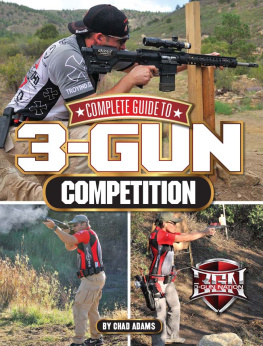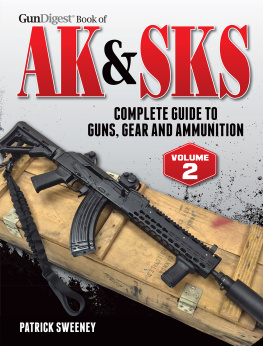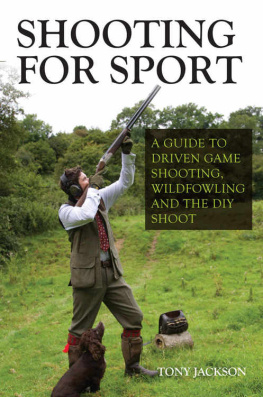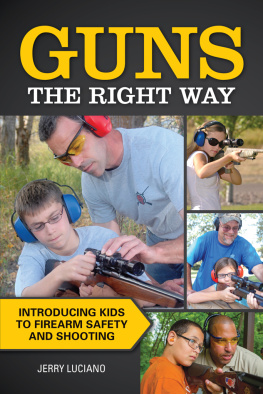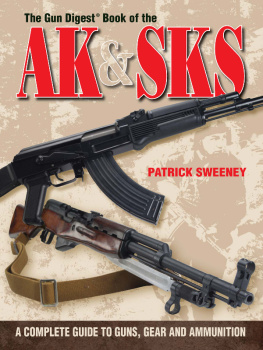COMPLETE GUIDE TO
3-GUN
COMPETITION
BY CHAD ADAMS
Acknowledgements
There are a tremendous number of folks to thank who have made this work possible. 3-gunners Patrick Kelley, Bryan Ray, Bruce Piatt, Rob Romero, Jansen Jones, Mike Voigt, Tommy Thacker, Taran Butler, Tony Holmes, and many more have patiently fielded my calls, returned my e-mails, and more. Match directors Dan Furbee, Andy Horner, JJ and Denise Johnson, Ken Flood, Mike, Rhonda and Travis Gibson and Tenille (Gibson) Chidester at MGM Ironman, Larry Houck, Sheldon Carruth, Kirk Broyles, Gary Welborn, and more have given me and my company access, explained their match design philosophy, and been instrumental in the success of 3GN thus far. A special thanks to NRA Board Member Joe DeBergalis, our patron saint of 3-Gun.
FNH USAs Ken Pfau and Tommy Thacker have been more than influential, and I am one among many who thanks them for providing sponsorship, support staff, knowledge, and even gear for our Tour. Federal Premium, Stag Arms, Cheaper Than Dirt, NSSF, Brownells, DoubleStar, Samson Manufacturing, Timney Triggers, Ruger, MGM Targets, SureFire, Leupold Tactical Opticsand many others also deserve much credit for their contributions. I, we, thank you one and all.

Intro
3-Gun Nation means a lot of things to a lot of different people in the sport of 3-gun. For some, its on the periphery of what they do, while others plan their entire shooting careers around the programs and competitive platforms developed by 3-Gun Nation (3GN). Regardless the level of ones involvement, since the debut of 3GN, in 2010, its hard to argue the dynamic explosion in the popularity of what we like to call the X-Games of the Shooting Sports.
I discovered 3-gun through my profession, which makes me unique. Most folks jobs simply dont enable them to go out and try new shooting sports with little financial investment or effort. So, I was lucky, because mine did. However, had I not had such amazing access to the firearms industry, Im not sure if I ever would have found what has become my passion.
On a fundamental level, I think theres something wrong with that.
I happened to grow up in small-town America, where there wasnt any particular interest, at least to my knowledge, in action shooting. Guns were for hunting, or for defense, or even simply for setting up tin cans and having fun. Football and basketball were sportsreal competition. My view of shooting while I was growing up really didnt equate the cool black and tactical guns I liked with any type of sport I knew anything about.
So thats the real purpose of this bookan attempt to educate folks, potentially like me, who are not acutely aware of what 3-gun is and how they can get involved. My job has enabled me to get to know the top shooters in the sport, and many of them have helped me along the way, teaching me what I, as a journalist, should be writing about, and how to relay that knowledge to newer shooters. This book is an attempt to take what Ive learned from the sport of 3-gun and package it into something useful for anyone interested in playing the game.
This book is for anyone interested in 3-gun, for the top shooters who have driven the sport, for the companies that support it, and for the next great stars of the game, the guys like Rustin Bernskoetter who are out there competing with a philosophy of shoot until my fingers bleed, as he says. I hope youll enjoy whats in the pages of this book and come join us in this exploding sport. Were truly looking forward to seeing you on the range.
Chad Adams

CHAPTER 1
3-GUN 101:
An Introduction to Americas Fastest Growing Shooting Sport

T he sport of 3-gun falls within the discipline known as action shooting, which really is a politically correct term for practical shooting, the sport based on the quest for a higher level of combat shooting. While action shooting has been formally presented in America now for several decades, it has taken various shapes.
Today, action shooting has many forms, most of which traces itself back to the formation of the International Practical Shooting Confederation, or IPSC. Later, the United States Practical Shooting Association was formed as the U.S. domain of IPSC, as IPSC is truly international and branches into many countries around the world. The USPSA remains the strongest region, boasting more than 20,000 members nationwide.

Match directors sometimes designate specific shooting boxes or shooting area, with fault lines, where shots must be fired to avoid penalty.
The International Defensive Pistol Association (IDPA) is an offshoot of IPSC-style shooting, formed by shooters unsatisfied with the gamesmanship perceived to be prevalent within USPSA matches and rules. IDPA currently claims more than 19,000 members, and its competitions differ from IPSCs primarily in their rules structure, which establish competitions leaning more towards self-defense or tactical-style shooting, rather than a test of pure shooting skills, as some view the matches of IPSC. Both USPSA/IPSC and IDPA have been extremely successful in the U.S., but primarily as organizations that promote and sanction pistol competition. 3-gun, while influenced by USPSA rules already in place, has developed outside the vacuum of any one governing body, although 3-Gun Nation is quickly becoming the entity that bridges many matches and clubs together.
A 3-Gun event, or match, is a collection of individual courses of fire, commonly called stages. During each stage of multiple targets, a competitor, under the direction of a range officer, negotiates that stagekeep in mind that this is an action sport, so theres lots of moving around from place to place, from one bank of targets to another, and so onengaging each target as described during the stage briefing given by the range officer before the timer buzzer goes off. That briefing varies in its instructions, ranging from strictly regimented courses that must be shot in a specific sequence, to free-form design, where the competitor is free to map their own strategy. A stage can have a specific starting area as limited as a small starting box, outlined by wood or metal staked into the ground. Stages can also have specific shooting areas, where certain targets must be engaged using particular firearms. Fault lines are sometimes present, and they mark the end of an area of movement for a competitorno shots may be fired outside of a shooting area or forward of a fault line without receiving penalty, which is applied to a shooters score in extra time.



